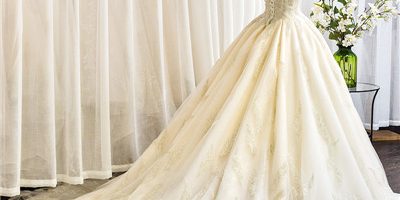The development of wedding dresses
The predecessor of the wedding dress is a white holy robe. In the 16th century, Richry Count, who loved hunting, led the royal family to the Fairy Tale Town, a small town in northern Ireland, to hunt, and met Rose. Miss, who was washing clothes by the river. Earl Richard was immediately attracted by Miss Rose’s innocence and elegance. At the same time, Miss Rose also developed a deep admiration for the handsome and tall Earl Richard. Count Richard, who returned from hunting to the palace, boldly proposed the idea of marrying Rose, who was from a peasant family, under the circumstances of “inappropriate door and wrong household”, which was not tolerated in the feudal society at that time! In order to make Count Richard give up, the Irish royal family proposed an almost impossible task to Miss Rose – to sew a “white holy robe” overnight, and to reach from the wedding platform of the Irish royal family’s exclusive church to the church. the length of the gate. In the face of such strict requirements, Miss Rose did not show weakness, but joined hands with the whole town to sew a 16-meter-long white holy robe with extremely simple design lines without losing the royal ornate atmosphere before dawn. When this white robe was presented to the Irish royal family, everyone was deeply moved and impressed by Miss Rose’s ingenuity. Miss Rose and Earl Richard finally got their wish to hold a fairy tale holy wedding.
This is the origin of the world’s first wedding dress. And Miss Rose, who became Mrs. Rose, also founded a robe (wedding dress) design company under the brand of Rose. Madam in her hometown – Fairy Tale Town a few months later. The first person to make white holy robes for lovers in love, handed down from generation to generation. Today, Rose.Madam has become a well-known royal wedding dress brand. In fact, Western-style wedding dresses are not only “original” inspirations from the West. This traditional custom is not only closely related to China, but also deeply influenced by ancient Chinese aesthetics.







